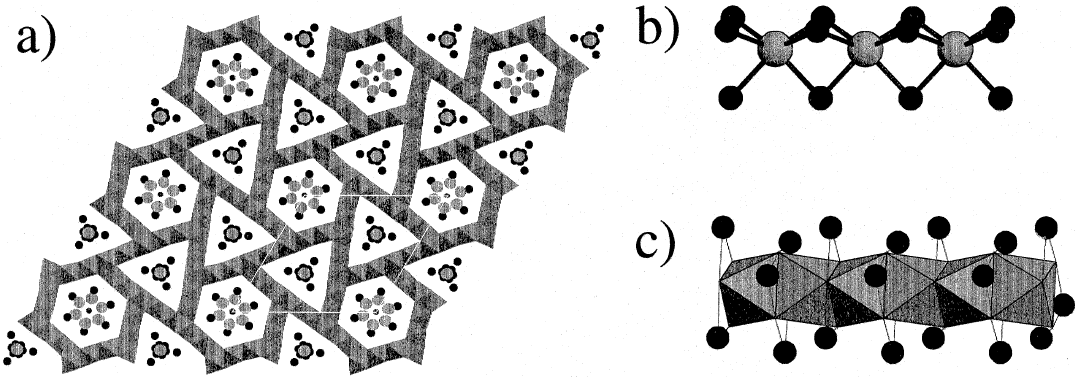=================================================================================
The structure [1] shown in Figure 3469a is formed by a three-dimensional (3-D) Cr7S12 framework raising the strips of edge-sharing octahedra {CrX6} as a triple twinning {111} of NaCl-type and thus, resulting in a hexagonal symmetry sublattice. This 3-D framework forms two different types of tunnels with hexagonal and trigonal geometry. The columns with composition A3CrX3 located in the hexagonal tunnels and the columns with composition A3X located in the trigonal tunnels. There are one hexagonal tunnel and two trigonal tunnels in an unit cell. Both types of columns present hexagonal lattices with the same lattice parameters.

Figure 3469a. (a) Ideal structure of PbCr2S4 projected onto (0001). Pb, Cr and S atoms are drawn as medium black, small black and big gray circles. (b) The triangular tunnels. Black spheres represent Pb atoms and the gray ones located in the center of the face sharing Pb-prisms are S atoms. (c) The hexagonal tunnels. The black spheres represent Pb atoms and the S atoms are located at the corners of the face-sharing octahedra which are centered by Cr atoms. [2]
Figure 3469b shows the electron diffraction pattern along any [hki0] zone axis. The reflection spots originate from the 3-D framework Cr21S36, while the diffuse diffraction lines originate from the two columnar substructures Pb6Cr2S6 and Pb3S. The lack of correlation between columns of the same type results in planes of diffuse intensity instead of well-defined reflections, even though some degree of correlation between the columns still exist since the diffuse intensity of the planes are not uniform in the figure.
![Electron diffraction pattern of a PbCr2S4 crystal oriented along the [2 -1 -1 0] zone axis](image1/3477c.jpg)
Figure 3469b. Electron diffraction pattern of a PbCr2S4 crystal oriented along the [2 -1 -1 0] zone axis.
[2]
[1] Hyde, B.G., Andersson, S., 1989. Inorganic Crystal Structures. Wiley, New York.
[2] Landa-Cánovas, A.R., Gómez-Herrero, A., and Carlos Otero-Díaz, L. Electron microscopy study of incommensurate modulated structures in misfit ternary chalcogenides, Micron 32 (2001) 481 - 495.
|

![Electron diffraction pattern of a PbCr2S4 crystal oriented along the [2 -1 -1 0] zone axis](image1/3477c.jpg)